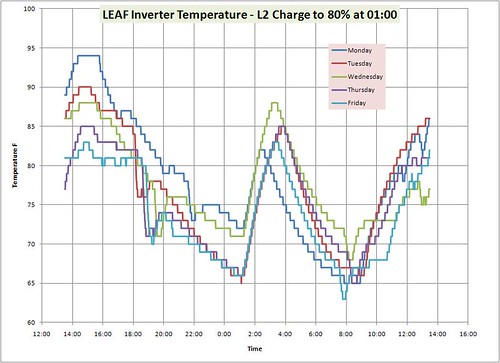Nekota
Well-known member
I placed a data logging device to measure temperature on top of the inverter cover just under the brake fluid reservoir. Charging was started at 1AM with Level 2 and charge stopped at 80% . The LEAF is driven 30 to 40 miles for commuting. The primary heat source seems to be from charging or the radiator is very effective at cooling the moving vehicle. The background temperature is dominated by the solar heating of the car during the day and some small dips in temperature when the LEAF is driven due to the cool down or moving air around the inverter when the LEAF is in motion.
The input power from the EVSE (AV model) is about 3800 W so the charger has to dissipate the 500 W which apparently goes into the cooling system which is shared between the charger, inverter and motor. Since the vehicle is stationary during charging the radiator does not provide much cooling until fans turn on when the temperature gets high enough. These charges are for 2 to 3 hours to recover the charge to 80%.

LEAFInverterTemp
It took several edits to get the Flickr image working.
The input power from the EVSE (AV model) is about 3800 W so the charger has to dissipate the 500 W which apparently goes into the cooling system which is shared between the charger, inverter and motor. Since the vehicle is stationary during charging the radiator does not provide much cooling until fans turn on when the temperature gets high enough. These charges are for 2 to 3 hours to recover the charge to 80%.

LEAFInverterTemp
It took several edits to get the Flickr image working.



